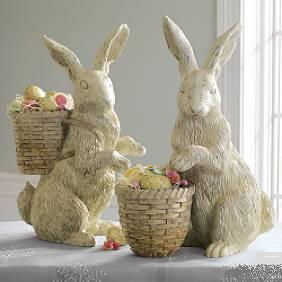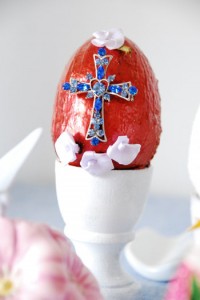Personal Thoughts on the Meanings of Easter
Happy Sunday to you.
I have much, much more to say on the topic of the scientifically supported description of God’s Creation, and I will continue those thoughts next week. In observance of Resurrection Sunday, I felt led to share my thoughts with you on the meaning of Easter as it applies to us.
 English speaking countries derived the name Easter from the pagan goddess, Eostre, and the bunny and colored eggs are direct adoptions of pagan traditions. Some people, myself included, instinctively recoil at the notion that the name “Easter” comes from the name of a pagan goddess, and that the predominant icons of the holiday are not the empty cross or the empty tomb of our Savior, but rather eggs and bunnies and baskets of paganism.
English speaking countries derived the name Easter from the pagan goddess, Eostre, and the bunny and colored eggs are direct adoptions of pagan traditions. Some people, myself included, instinctively recoil at the notion that the name “Easter” comes from the name of a pagan goddess, and that the predominant icons of the holiday are not the empty cross or the empty tomb of our Savior, but rather eggs and bunnies and baskets of paganism.
While Hallee and I have (obviously) not been able to discuss our thoughts and feelings about this in person, we both immediately spiritually recoiled when we discovered that the name of Easter came from a pagan tradition and that the icon that is the “Easter Bunny” and colorful eggs are directly related to the pagan traditions. This Easter Sunday, I will divert from the Creation debate to share with you 1) why I think that spiritual recoil had such an impact on our household, and 2) what I think we are going to do as the spiritual leaders of our family for ministry as a result.
Why I Think That Spiritual Recoil had Such an Impact
 In scripture, the process of sanctification is revealed to us. As a people, believers are directed to be “set apart” from unbelievers. We are directed to be of the world, not in the world. There are many details, all of which have to be translated with respect to intent and then applied to our modern world. For over a year now, our family has been hypervigilant to the more insidious influences of the world, and we have been eliminating them from our lives.
In scripture, the process of sanctification is revealed to us. As a people, believers are directed to be “set apart” from unbelievers. We are directed to be of the world, not in the world. There are many details, all of which have to be translated with respect to intent and then applied to our modern world. For over a year now, our family has been hypervigilant to the more insidious influences of the world, and we have been eliminating them from our lives.
If one has the courage of one’s convictions, one sacrifices nearly all secular forms of entertainment: TV cable gets shut off, the DVD racks and CD collection essentially get emptied out, and the radio is limited to one or two stations. One sacrifices the Standard American Diet (SAD) in favor of Good Real Food the way God intended: which realistically can strain efforts at stewardship with respect to time management and budget and also requires real planning in the event you are away from home for any period of time. This can be stressful. One has to shield and prepare one’s children for their baptism into secular humanism at the hands of usually well-intentioned (and occasionally purposefully malicious) public school teachers and officials. These are just the high spots.
Sanctification and the desire to live a pure life is an ongoing process. The painful part is that “repentance” part. That part of you that realizes you had that beam in your own eye for years while looking at everyone else’s splinters. The part that realizes in hindsight just how vulnerable you were to being “of” the world instead of just “in” the world despite your sincere efforts. That part of you that knows the depth to which you compromised your principles. It’s like going through surgery and, when the cancerous growth is excised, though you are ultimately healthier afterward, there is still always a recovery period throughout which you feel raw and weak and little everyday things hurt when they shouldn’t.
At some point, it becomes overwhelming to realize just how embedded sin and the ways of the world are in our society — and in our own lives. At some point, in your quest for purity, you hope for the safe-haven of something that is entirely pure, entirely safe, entirely holy.
And then you learn that the most holy of Christian celebrations celebrates icons of paganism and derived it’s very name from a pagan goddess. It had us feeling pretty disappointed to be honest.
What I Think We are Going to Do
So here’s what we are going to do about it. I think what we are called to do is to tell our children the entire truth. What I mean by that is we need to tell them all about how people once believed in a goddess named Eostre, who took a frozen bird and gave it a new life as an egg laying bunny… a gift to another pagan goddess named Ishtar, the goddess of fertility, who the rabbit and eggs were meant to honor. We should tell them about how these beliefs were abandoned once the truth of the Gospel was revealed, but about how the pagan traditions remained.
 Throughout history, Christians have used universal symbols to demonstrate a deeper meaning. For example, in ministering to the pagans in Ireland, St. Patrick used the three leaves of the Shamrock which pagans believed represented pagan gods — with the rare fourth leaf denoting “Luck” or good fortune, from “Fortuna” the moon goddess — and used it to demonstrate the three aspects of God in the Holy Trinity of God the Father, God the Son, and God the Holy Spirit.
Throughout history, Christians have used universal symbols to demonstrate a deeper meaning. For example, in ministering to the pagans in Ireland, St. Patrick used the three leaves of the Shamrock which pagans believed represented pagan gods — with the rare fourth leaf denoting “Luck” or good fortune, from “Fortuna” the moon goddess — and used it to demonstrate the three aspects of God in the Holy Trinity of God the Father, God the Son, and God the Holy Spirit.
The celebration of Easter is the feast of the Resurrection of Jesus Christ. As such it has its origins in a purely Christian foundation. True, the word Easter comes from paganism. But the word itself means, “Great Day” or “Blessed Day” and there is no more perfect day in the history of the world than the day upon which Christ rose from the dead. The actual festival of the Resurrection is not even called Easter in other languages, but is always some derivation of the word “Pascha.”
The word Pascha is the noun form of the word Paschal, which is applied to the Christian celebration of Easter and the Jewish celebration of Passover. In Hebrew, Passover is Pesach, while Paschal refers to either the feast of Passover or the Christian celebration of Easter. Pascha is the feast of Christ’s resurrection from the dead, the Christian celebration of Easter.
Christians have historically used universal symbols to celebrate Easter that are not specifically of either Jewish or Christian heritage, just as St. Patrick and his Shamrock. As the gospel spread through the English speaking world, entire towns converted from paganism to Christianity. Most people probably simply continued to refer to the new Christian festival by the name of the old pagan festival that used to happen around the same time before they knew the truth.
 Eggs, which represent new life, have likewise been a symbol of spring since ancient times. The pagan connection should not be dismissed. Ishtar was the goddess of fertility and reproduction. Rabbits are also associated with the fertility of spring because of their ability to produce many young. Christians adopted the egg and the bunny as Easter symbols because of the relationship between Christ’s resurrection and the renewal of life.
Eggs, which represent new life, have likewise been a symbol of spring since ancient times. The pagan connection should not be dismissed. Ishtar was the goddess of fertility and reproduction. Rabbits are also associated with the fertility of spring because of their ability to produce many young. Christians adopted the egg and the bunny as Easter symbols because of the relationship between Christ’s resurrection and the renewal of life.
We will educate our children on this history while we also explain to our children that rabbits are merely animals, created by God, and that eggs are merely food. Neither has any holy or magical significance. We will explain that they are symbols of a deeper meaning in God’s revealed truth.
In Greece, there is a traditional Easter bread called Tsoureki, which is a braided sweet bread that includes a brightly colored red egg. In that tradition, the red symbolizes Christ’s blood and the egg itself symbolizes the new life of His resurrection. When we come to Christ through his blood, we have new life.
I think we are on the right track. We limit the entirely blatant secular influences and emphasize the Christian messages. Moving forward, we add education to the mix. We educate our children about how knowing the truth of Christ’s resurrection once put brightly colored eggs in context for unbelievers and brought them into our family. We can explain how the “Great and Blessed Day” of Easter is the greatest and most blessed day because Jesus Christ who shed His blood for us conquered the grave, and how we, likewise, received the gift of eternal life as a result.
May God Bless you today and everyday.
Gregg


I like this post Gregg. I have been struggling this year with just how to celebrate Easter. We have, typically, never really done too much of anything, but I wanted to shift the focus this year to the ‘real’ meaning of Easter. My seven year old now knows the truth. That, although he has never visited our home before, there is no Easter Bunny that magically brings baskets and eggs and gifts. We didn’t even dye eggs this year. I am fine, however, with the egg ‘stuff’ that the kids bring home from school, and the gifts that their Grandma’s HEAP upon them. :) I will be sure to remind and repeat what Easter is REALLY all about, and although our Grandma’s are generous to give us gifts from them(grandmas), the thing we need to be TRULY thankful for is that God sacrificed His son for us and that we can live our lives because of that. We will be thankful for the miracle that occurred many thousands of years ago inside an empty tomb. I, myself, am relatively new on my journey to faith and this Easter has meant a lot to me and I am glad to be able to share that with my children.
Thank you Gregg this was very helpful to for me. God bless